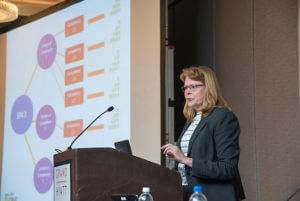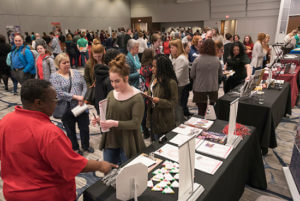
Dr. Kathy Salisbury, PVM associate dean for academic affairs, gives a presentation at the 2018 AAVMC Annual Meeting about Entrustable Professional Activities that are part of the new Competency-Based Veterinary Education Framework. (Photo courtesy of AAVMC)
This year’s annual meeting of the Association of American Veterinary Medical Colleges (AAVMC) was focused on the theme “Innovation in Education,” and, fittingly, included the unveiling of a new Competency-Based Veterinary Education (CBVE) framework. Designed to improve veterinary medical education and quality assurance, the program was developed by the AAVMC CBVE Working Group, consisting of ten national and international veterinary medical professors, including Dr. Kathy Salisbury, Purdue Veterinary Medicine associate dean for academic affairs and professor of small animal surgery.
The CBVE program is an outcomes-based, learner-centered approach to veterinary medical education that uses a shared framework and language to help ensure that every veterinary medical college student graduates with competencies that enable them to be successful from their first day as independent veterinarians. In developing the program, the CBVE Working Group built upon existing frameworks deployed in other areas of health education and incorporated extensive feedback from employer and graduate surveys.
Dr. Salisbury was among the speakers who gave presentations about the CBVE program at the AAVMC Conference, held March 2-4 in Washington, D.C. Since the CBVE Working Group was convened, the members have logged thousands of emails, over 100 video-conference meetings, 20 face-to-face meetings, 20 stakeholder engagements to gather input and ideas, two formal surveys, multiple expert consultations, and communications with the AVMA Council on Education. The resulting CBVE framework seeks to clarify what abilities students need upon graduation and to elucidate steps that demonstrate the progression of necessary expertise.
“This framework, which represents the latest pedagogical thinking and best practices, lays the foundation for colleges and schools to develop competency-based education,” said AAVMC Chief Executive Officer Andrew Maccabe, noting that the CBVE program is one of the most substantial pedagogical initiatives ever undertaken by the AAVMC.
“Colleges and schools will benefit from a common language and a more comprehensive picture of graduate outcomes based upon evidenced-based criteria and agreed-upon standards from some of veterinary medicine’s best educators and the latest research,” Dr. Maccabe said. “It’s not a final product, but a first step in a journey of co-creation.” The working group is currently developing milestones that represent steps in the mastery of competencies, on a scale from novice to proficient.

The Purdue University College of Veterinary Medicine was among 20 veterinary schools and colleges represented at the Career Fair held March 4 in conjunction with the AAVMC Annual Meeting in Washington, D.C. (Photo courtesy of AAVMC)
Click here for a complete story about the CBVE program. Two booklets were published and distributed at the AAVMC meeting and can be downloaded from the AAVMC website. One is an overview of the CBVE framework, which consists of nine domains of competence, each representing a group of related abilities necessary for veterinary graduates. The other booklet on “Entrustable Professional Activities” (EPA) identifies eight core EPAs for veterinary education and outlines the relationship between each EPA and its associated domains and competencies.
The AAVMC annual meeting was attended by some 265 educators who gathered to gain fresh ideas and new perspectives on technology, assessment, multicenter collaboration, international academic veterinary medicine, and a host of other topics. Presentations ranged from a virtual reality excursion through a dog’s circulatory system to an examination of how the veterinary medical profession’s counterparts in human medical education handle quality assurance in professional education. The conference wrapped-up with the AAVMC Career Fair that drew an estimated 500 prospective veterinary students and guests. A total of 20 veterinary medical schools and colleges, including the Purdue University College of Veterinary Medicine, participated in the career fair with display tables staffed by college representatives.
